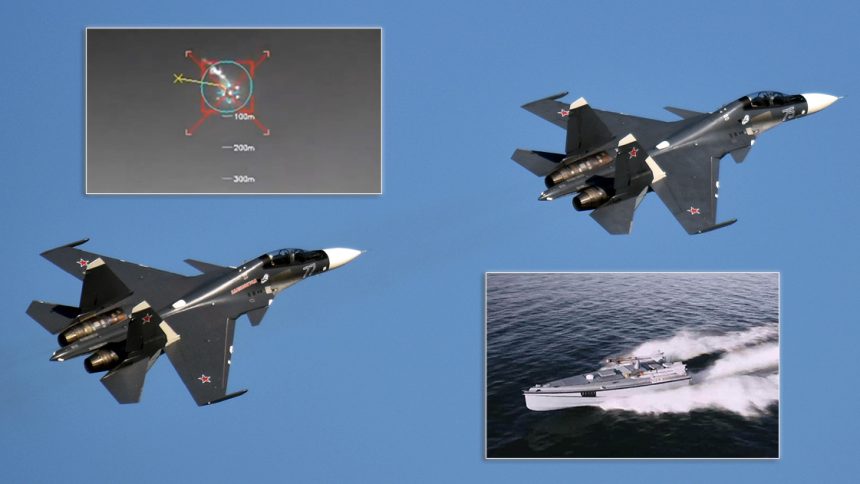The recent shootdowns of Russian Su-30SM aircraft by missile-equipped USVs highlight a significant leap in Ukraine’s anti-aircraft capability.
As you may already know by now, on May 2, 2025, Ukraine achieved something unprecedented: an Su-30 Flanker was shot down over the Black Sea by a missile fired not from an aircraft, nor a ground-based air defense system, but from a drone boat. A few days later, a second Flanker went down the same way. These are the first two confirmed kills of fast-moving fighter jets by uncrewed surface vessels (USVs). And judging by how fast Ukraine is evolving this capability, there are significant chances they won’t be the last.
What we’re seeing is not just innovation, but mostly the reshaping of tactical doctrine in real time.
World first: On May 2, 2025, the @DI_Ukraine special operations unit, in coordination with the Security Service of Ukraine and Defence Forces of Ukraine, eliminated a russian Su-30 fighter jet in the Black Sea.
🔗 https://t.co/DXhg74AKcg pic.twitter.com/Z4fP5CFRb8
— Defence Intelligence of Ukraine (@DI_Ukraine) May 3, 2025
Initial reports pointed to the use of the well-known Magura V5, but it has now been confirmed that the aircraft were downed by the Magura V7, a larger, more mature version of Ukraine’s already formidable naval drone.
🚨
Naval News can confirm that a Sidewinder-armed Magura V7 surface drone (USV) shot down two Russian Su-30 FLANKER jets. This is the first time that the V7 variant has been revealed to the public 🇺🇦💥🇷🇺@CovertShores has the story (and the picture) 👇https://t.co/bxa9AAV7u3
— Naval News (@navalnewscom) May 4, 2025
The V7, about 8 meters long, appears optimized for rougher sea conditions and carries a much more refined payload system than earlier models. Notably, it does not feature the bow-mounted explosive charge typical of kamikaze-style variants, suggesting a mission profile focused on stand-off strike rather than close-in attack.
But the real surprise? The V7 appears to be armed with AIM-9 Sidewinder missiles, a significant departure from the earlier R-73-equipped “Sea Dragon” configuration. The missiles are mounted on what look like elevating launch rails, allowing the USV to engage targets with a degree of flexibility we haven’t seen before in naval drone warfare.
While range is likely limited, possibly within 10 km, it was enough to hit some pretty advanced jets. The combination of some degree of low observability, surprise, and mobility makes these drone boats a serious threat even to high-speed, maneuverable aircraft like the Su-30.
This isn’t Ukraine’s first reported shootdown using a drone-launched missile. On Dec. 31, 2024, the Ministry of Defense of Ukraine posted on its Telegram and X accounts a video from Ukraine’s Military Intelligence, showing the downing of Russian Mi-8 helicopter by a Magura V5 naval drone, armed with R-73 air-to-air missiles repurposed as improvised surface-to-air weapons.
As we commented when the previous downing happened last year:
The use of air-to-air missiles from ground positions is not new to Ukraine either. For instance, Ukraine is already using the AIM-9X as ground-launched missiles fired by NASAMS (National Advanced Surface-to-Air Missile System), as well as modified 9K33M3 Osa-AKM systems equipped with the R-73.
Modified Sidewinders were used in the American MIM-72 Chaparral, while Israel has fielded the Spyder system with modified Python-5 IR missiles and France employs modified VL-MICA IR missiles for naval and ground-launched applications. Similarly, Germany is producing an air defense system based on ground-launched versions of the IRIS-T missiles, with various units already donated to Ukraine. The Yemeni Houthi terrorist group also repurposed air-to-air missiles to shoot at Saudi airplanes and American drones.
But taking down not one, but two fast jets, especially combat-proven Flankers, is something else entirely. It speaks to a rapidly maturing capability, both technically and operationally.
For the Russian Air Force, this is another complication in an increasingly hostile battlespace. While USVs have mostly been associated with anti-ship or reconnaissance roles, they now represent an asymmetric air defense threat one that can pop up from the sea and target fighters as they operate at low altitude.
The success of Ukraine’s drone boat campaign, from ramming and sinking Russian warships to now taking out fighters, marks a fundamental shift in naval and air warfare. If kamikaze drones were the first wave, missile-armed surface drones are the next evolution.
And the implications go far beyond the Black Sea, with many other nations likely taking notes of the Ukrainian achievements in the field…









